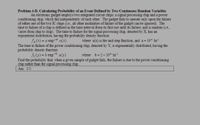
A First Course in Probability (10th Edition)
10th Edition
ISBN: 9780134753119
Author: Sheldon Ross
Publisher: PEARSON
expand_more
expand_more
format_list_bulleted
Question
Mm1

Transcribed Image Text:Problem 4-D. Calculating Probability of an Event Defined by Two Continuous Random Variables
An electronic gadget employs two integrated circuit chips: a signal processing chip and a power
conditioning chip, which fail independently of each other. The gadget fails to operate only upon the failure
of either one of the two IC chips (i.e., all other modalities of failure of the gadget can be ignored). The
time to failure of a chip is defined as the time interval from its first use until its failure, and is random (i.e.,
varies from chip to chip). The time to failure for the signal processing chip, denoted by X, has an
exponential distribution, having the probability density function
where u(x) is the unit step function, and a = 10+ hr
The time to failure of the power conditioning chip, denoted by Y, is exponentially distributed, having the
fx(x) = a exp-* u(x)
probability density function
f; (y) = b exp- u(y)
-by
where b= 2× 10+ hr'
Find the probability that, when a given sample of gadget fails, the failure is due to the power conditioning
chip rather than the signal processing chip.
Ans. 2/3.
Expert Solution
This question has been solved!
Explore an expertly crafted, step-by-step solution for a thorough understanding of key concepts.
This is a popular solution
Trending nowThis is a popular solution!
Step by stepSolved in 2 steps

Knowledge Booster
Similar questions
Recommended textbooks for you
 A First Course in Probability (10th Edition)ProbabilityISBN:9780134753119Author:Sheldon RossPublisher:PEARSON
A First Course in Probability (10th Edition)ProbabilityISBN:9780134753119Author:Sheldon RossPublisher:PEARSON

A First Course in Probability (10th Edition)
Probability
ISBN:9780134753119
Author:Sheldon Ross
Publisher:PEARSON
